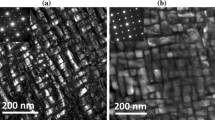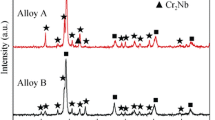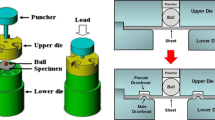Abstract
The present paper studied the solid-state phase transformations occurring at the grain boundaries of a conventional cast-and-wrought alloy within the chemical specifications of superalloy Inconel 718. These phase transformations involved the precipitation of (Nb,Mo)2CrB2 borides and (Nb,Ti)2CS carbosulfides, which are usually phases rather associated to solidification phenomena than to solid-state phase precipitation in superalloy Inconel 718. The study started from a material solution-treated above the δ solvus. When this material was heated subsolvus δ from room temperature, (Nb,Mo)2CrB2 borides was found to precipitate at the grain boundaries, in addition to the δ phase. Then, when the material was reheated supersolvus δ after the subsolvus treatment, the complete dissolution of the δ phase and the partial dissolution of the (Nb,Mo)2CrB2 phase released niobium and titanium atoms in the grain boundaries. Both elements have a strong affinity with carbon and sulfur, and this favored the precipitation of secondary (Nb,Ti)C carbides and (Nb,Ti)2CS carbosulfides at grain boundaries. An analysis of the interactions between the segregating species C, B and S evidenced that the precipitation of (Nb,Mo)2CrB2 borides at grain boundaries was very likely made possible by a decreased carbon activity during the subsolvus δ treatment.


















Similar content being viewed by others
References
R.E. Schafrik, D.D. Ward, and J.R. Groh: in Superalloys 718, 625, 706 and Various Derivatives, TMS, 2001, pp. 1–11.
G.D. Smith and S.J. Patel: in Superalloys 718, 625, 706 and Derivatives, TMS, 2005, pp. 135–54.
M.G. Burke and M.K. Miller: in Superalloys 718, 625 and Various Derivatives, TMS, 1991, pp. 337–50.
S.T. Wlodek and R.D. Field: in Superalloys 718, 625, 706 and Various Derivatives, TMS, 1994, pp. 659–70.
M. Sundararaman, P. Mukhopadhyay, and S. Banerjee: in Superalloys 718, 625, 706 and Various Derivatives, TMS, 1997, pp. 367–78.
H.E. Collins: in International Symposium on Structural Stability in Superalloys (1968), TMS, 1968, pp. 171–98.
7 I. Kirman: J. Iron Steel Inst., 1969, vol. 207, p. 1612.
8 I. Kirman and D.H. Warrington: Metall. Trans., 1970, vol. 1, pp. 2667–75.
9 M. Dehmas, J. Lacaze, A. Niang, and B. Viguier: Adv. Mater. Sci. Eng., 2011, vol. 2011, pp. 1–9.
A. Mitchell, A.J. Schmalz, C. Schvezov, and S.L. Cockroft: in Superalloys 718, 625, 706 and Various Derivatives, TMS, 1994, pp. 65–78.
11 A. Formenti, A. Eliasson, A. Mitchell, and H. Fredriksson: High Temp. Mater. Process., 2005, vol. 24, pp. 239–58.
12 R.T. Holt and W. Wallace: Int. Met. Rev., 1976, vol. 21, pp. 1–24.
M.K. Miller, J.A. Horton, W.D. Cao, and R.L. Kennedy: Le J. Phys. IV, 1996, vol. 06, pp. C5-241-C5-246.
14 T.M. Pollock and S. Tin: J. Propuls. Power, 2006, vol. 22, pp. 361–74.
15 S. Benhadad, N.L. Richards, and M.C. Chaturvedi: Metall. Mater. Trans. A, 2002, vol. 33A, pp. 2005–17.
W.D. Cao and R.L. Kennedy: in Superalloys 1996, TMS, 1996, pp. 589–97.
J.T. Guo and L.Z. Zhou: in Superalloys 1996, TMS, 1996, pp. 451–55.
18 D.W. Yun, S.M. Seo, H.W. Jeong, and Y.S. Yoo: Corros. Sci., 2014, vol. 83, pp. 176–88.
19 W.R. Sun, S.R. Guo, D.Z. Lu, and Z.O. Hu: Mater. Lett., 1997, vol. 31, pp. 195–200.
20 R. Vincent: Acta Metall., 1985, vol. 33, pp. 1205–16.
21 W. Chen, M.C. Chaturvedi, N.L. Richards, and G. McMahon: Metall. Mater. Trans. A, 1998, vol. 29, pp. 1947–54.
22 L. Peng, S. Takizawa, K. Ikeda, T. Horiuchi, and S. Miura: Intermetallics, 2019, vol. 110, pp. 2–7.
Alloy Wire International: Inconel® 718, https://www.alloywire.fr/products/inconel-718/.
24 E. Nes, N. Ryum, and O. Hunderi: Acta Metall., 1985, vol. 33, pp. 11–22.
25 S. Vernier, J.-M. Franchet, M. Lesne, T. Douillard, J. Silvent, C. Langlois, and N. Bozzolo: Mater. Charact., 2018, vol. 142, pp. 492–503.
26 B. Ter-Ovanessian, C. Berrest, J. Deleume, J.M. Cloué, and E. Andrieu: Defect Diffus. Forum, 2009, vol. 289–292, pp. 161–6.
27 G. Love, V.D. Scott, N.M.T. Dennis, and L. Laurenson: Scanning, 1981, vol. 4, pp. 32–9.
28 F.J. Humphreys: J. Mater. Sci., 2001, vol. 36, pp. 3833–54.
29 H.J. Beattie: Acta Crystallogr., 1958, vol. 11, pp. 607–9.
30 J. Berlin: Imaging Microsc., 2011, vol. 13, pp. 19–21.
31 H. Müllejans and J. Bruley: Le J. Phys. IV, 1993, vol. 3, pp. 2083–92.
32 J.J. Lander, H.E. Kern, and A.L. Beach: J. Appl. Phys., 1952, vol. 23, pp. 1305–9.
33 K. Takagi, W. Koike, A. Momozawa, and T. Fujima: Solid State Sci., 2012, vol. 14, pp. 1643–7.
34 A. Miyoshi and A. Hara: J. Japan Soc. Powder Powder Metall., 1965, vol. 12, pp. 78–84.
ATI Allvac Company: ATI 718 Alloy—Technical Data Sheet, 2011.
36 F. Masoumi, M. Jahazi, D. Shahriari, and J. Cormier: J. Alloys Compd., 2016, vol. 658, pp. 981–95.
37 W. Kesternich: MRS Proc., 1985, vol. 62, p. 229.
38 E.P. Whelan and M.S. Grzedzielski: Met. Technol., 1974, vol. 1, pp. 186–90.
R.G. Thompson, M.C. Koopman, and B.H. King: in Superalloys 718, 625, 706 and Various Derivatives, 1991, pp. 53–70.
40 T. Alam, P.J. Felfer, M. Chaturvedi, L.T. Stephenson, M.R. Kilburn, and J.M. Cairney: Metall. Mater. Trans. A, 2012, vol. 43, pp. 2183–91.
41 D. Raabe, M. Herbig, S. Sandlöbes, Y. Li, D. Tytko, M. Kuzmina, D. Ponge, and P.-P. Choi: Curr. Opin. Solid State Mater. Sci., 2014, vol. 18, pp. 253–61.
42 P. Kontis, H.A.M. Yusof, S. Pedrazzini, M. Danaie, K.L. Moore, P.A.J. Bagot, M.P. Moody, C.R.M. Grovenor, and R.C. Reed: Acta Mater., 2016, vol. 103, pp. 688–99.
43 Y.Q. Li and J.Y. Liu: High Temp. Technol., 1990, vol. 8, pp. 278–82.
44 M. Paju and R. Möller: Scr. Metall., 1984, vol. 18, pp. 813–5.
45 X.L. He, Y.Y. Chu, and J.J. Jonas: Acta Metall., 1989, vol. 37, pp. 2905–16.
46 H. Erhart and H.J. Grabke: Met. Sci., 1981, vol. 15, pp. 401–8.
47 L. Xiao, D.L. Chen, and M.C. Chaturvedi: Mater. Sci. Eng. A, 2006, vol. 428, pp. 1–11.
48 P. Kontis, E. Alabort, D. Barba, D.M. Collins, A.J. Wilkinson, and R.C. Reed: Acta Mater., 2017, vol. 124, pp. 489–500.
49 J.M. Walsh and B.H. Rear: Metall. Trans. A, 1975, vol. 6, pp. 950–950.
50 H. Guo, M.C. Chaturvedi, and N.L. Richards: Sci. Technol. Weld. Join., 1998, vol. 3, pp. 257–9.
D. Monceau and C. Boudias: CaRine Crystallography, 1993-2019, http://carine.crystallography.pagesperso-orange.fr/.
Acknowledgments
The authors thank the STAE foundation for the funding of the present study. They are also grateful to the staff of the UMS Raimond Castaing (Toulouse, France) who provided a precious support for the characterization of the microstructures. Finally, the authors are grateful to Pr. J. Lacaze who performed ThermoCalc calculations and recommended interesting papers from literature.
Author information
Authors and Affiliations
Corresponding author
Additional information
Publisher's Note
Springer Nature remains neutral with regard to jurisdictional claims in published maps and institutional affiliations.
Manuscript submitted 17 February 2020; Accepted 22 September 2020.
Appendix
Appendix
SAED patterns acquired on the particle 1 of Fig. 7. From (a) to (d): experimental diffraction pattern (left) and the corresponding diffraction pattern from the simulation (right). Simulated diffraction patterns were obtained using the CaRine software.[51] The simulation is based on the tetragonal structure P4/mbm (space group number: 127) whose lattice parameters were set to a = 5.72 Å and c = 3.09 Å
Stereographic projection of the tetragonal structure P4/mbm overlaid with the beam directions used for the SAED acquisitions. The SAED analyses were all performed on the particle 1 of Fig. 7. The stereographic projection was drawn using the CaRine software[51] (a = 5.72 Å and c = 3.09 Å). It was approximately oriented so as to best fit with the acquisition frame. For each SAED acquisition, the electron beam direction is defined by the two tilt angles \( \varvec{\theta}_{1} \) and \( \varvec{\theta}_{2} \). The beam directions used for the four SAED patterns shown in Fig. A1 are displayed in red. The fifth direction displayed in blue correspond to another SAED pattern which was also consistently indexed with the tetragonal structure P4/mbm but which is not shown here for the sake of brevity (Color figure online)
EELS analysis performed on a (Nb,Mo)2CrB2 boride lying at a grain boundary. (a) HAADF STEM image. The blue arrow highlights the (Nb,Mo)2CrB2 boride which was analyzed. (b) EELS spectrum acquired in the location pointed by the red cross in (a). The K edge of boron, the L edge of chromium and the M edges of niobium and molybdenum were drawn over the acquired spectrum. This way, it clearly appears that in addition to niobium, molybdenum and chromium, the precipitate does contain boron (Color figure online)
Rights and permissions
About this article
Cite this article
Vernier, S., Pugliara, A., Viguier, B. et al. Solid-State Phase Transformations Involving (Nb,Mo)2CrB2 Borides and (Nb,Ti)2CS Carbosulfides at the Grain Boundaries of Superalloy Inconel 718. Metall Mater Trans A 51, 6607–6629 (2020). https://doi.org/10.1007/s11661-020-06045-z
Received:
Accepted:
Published:
Issue Date:
DOI: https://doi.org/10.1007/s11661-020-06045-z







